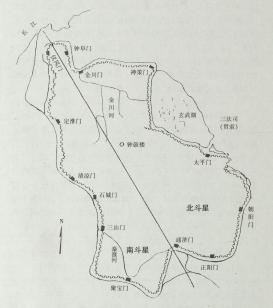In the middle of the fourteenth century, Zhu Yuanzhang, the founding emperor of the Ming Dynasty, expanded a city in Nanjing with the power of the whole country and designated it as the capital of the Ming Dynasty. This city, surrounded by four walls and covering a total area of 243 square kilometers, creatively integrated the landscape of nature. Its uniqueness in form, grandness in scale, dissemination of fortification technology, vastness of the area, far-reaching influence, and the large number of the people involved all grant it a unique position and significance in the history of Chinese urban planning and city wall construction. There is little primary literature concerning this fourteenth-century national urban construction project that brought together various technical elites from all over the country. In the Ming Dynasty, because the urban design of Nanjing involved the traditional imperial and divine consciousness that “cannot be revealed,” no one dared to reveal its truth. The City Wall of Nanjing, possibly divined by the important minister Liu Ji, was based on the knowledge of ancient Chinese astronomy, combined with the needs of imperial power and the geographical environment of Nanjing at that time. What was the role of Zhu Yuanzhang, as the emperor, in the urban design and construction of the city? Was Liu Ji’s divination influenced by other people or thoughts? What is traditional, and what is innovative in the construction technology of the City Wall of Nanjing, and how was this technology disseminated? This project focuses on the relationship between imperial power and divine power under the Chinese monarchy (such as ancient astronomical knowledge, fengshui, geomancy, and geographic environment recognition). It examines, in particular, how the ruling group strengthened imperial power in the process of selection, utilization, and rejection of secular beliefs, and how Zhu Yuanzhang and Liu Ji reflected this “heaven” consciousness through the shape of the City Wall, the layout, orientation, and names of the main buildings in the city construction of Nanjing. Secondly, this project looks into how the formation of the country’s major labor system in the fourteenth century, its impact on society, the use and dissemination of fortification technology, and the quality control of fortification materials reflected the establishment of centralized power and the spread of fortification technology in the early Ming Dynasty.

